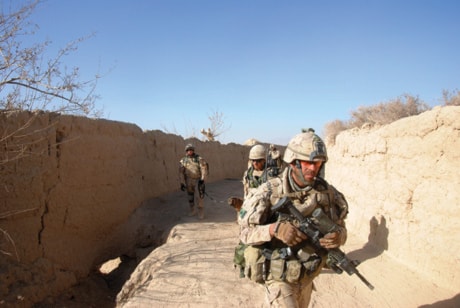KHENJAKAK, Afghanistan — The chopper comes in hard and fast, banking sharply before slamming onto a patch of rutted soil. Troops charge out the back of the Chinook and form a protective cordon. They kneel in the dirt and scan the horizon, rifles ready.
The sun has not yet risen. To the east looms the village of Khenjakak, a maze of mud-walled compounds and grape huts. Each one needs to be searched for the tools of the insurgents’ deadly trade.
Soldiers from the Afghan army set out across the cracked earth that lays between the landing pad and the first compound, trailed by Canadian troops and three Americans. The soldiers tread carefully, each step deliberate. The threat of makeshift bombs has that effect.
Birds chirp in the trees. Boots crunch the earth. Two Griffon helicopters whirl overhead. Otherwise, it is quiet. Khenjakak looks deserted.
Military intelligence identified the village as a Taliban hiding spot. Until recently, foreign troops had rarely patrolled this part of southern Kandahar province. Their absence let the insurgents move freely, crossing in and out of safe havens in neighbouring Pakistan. The Taliban stage attacks out of Khenjakak. They move supplies and weapons along the nearby Tarnak River to other parts of the province.
Military officers suspect they caught the Taliban by surprise last week when they raided Khenjakak for the first time. No one shot at them and the bombs they found were disconnected, a sign that the insurgents weren’t expecting foreign troops to find them.
This time could be different. The insurgents know Khenjakak is being targeted. Soldiers at Forward Operating Base Imam Sahib expect a fight. Or booby traps.
They get neither. The compounds at the edge of the village are empty. So are the grape huts. The soldiers press deeper into Khenjakak. The sun is up and villagers are beginning to stir. Children linger in doorways and watch the soldiers pass along the dusty streets. They hide their faces when they see a camera. The bolder children come out of their homes to follow the troops. Men sit on doorsteps or in their yards. The women hide.
“We know there are Taliban here,” says Sgt. Hugo Veilleux, sections commander of 5 Platoon, B Company.
They find their first cache of weapons at noon. The insurgents had hidden a rocket casing filled with metal shards in one of the compounds. The insurgents mount this kind of bomb at head-level so its blast decapitates anyone who triggers it.
The soldiers decide to blow up the explosive. They call what they are about to do a “bip,” or a blow in place. They take cover and start the countdown. The blast punches the air as a plume of smoke and dust casts a shadow across a farmer’s field.
About an hour later, an Afghan translator tells the Canadians that the ANA has found bomb-making equipment in a grape hut. Veilleux greets Afghan commander Mohammad Naser Khan under an archway leading to the compound.
“Big IED,” Khan says.
“Big IED? Good,” Veilleux replies.
Inside the grape hut, the soldiers find a metal pressure plate, wires and a burlap sack filled with explosives. They decide to blow it up.
The explosion spews dust through the slits of the grape hut.
Soon they get lucky for a third time. The Afghans find wires, batteries, a jug of explosives and a pressure plate - all the deadly implements needed to make a bomb - inside the last compound they search. Like the others, this one must be blown up. The soldiers take cover behind a mud wall running through a field. The blast showers them in dust and debris.
The sun is setting and it’s time to get out of Khenjakak. A Chinook hovers in the distance as Veilleux takes stock of the day. Four kilometres covered. Three weapons caches found.
“We do a lot of ground today,” he says.
